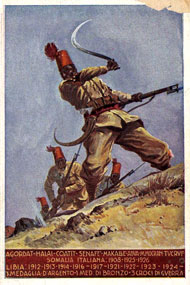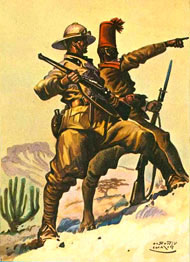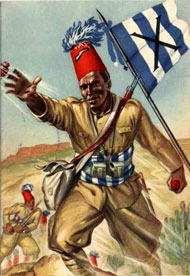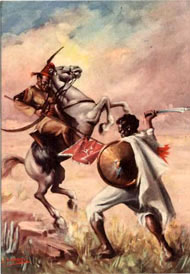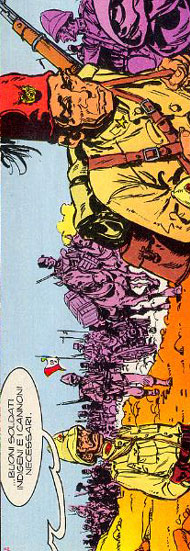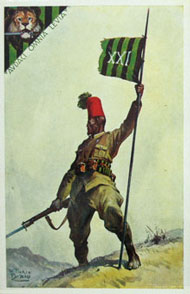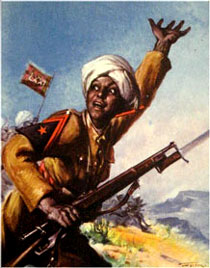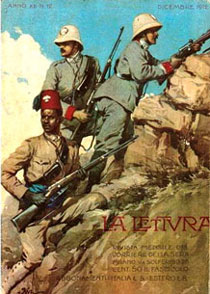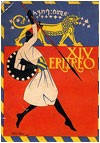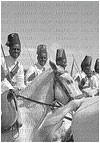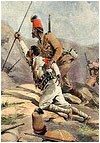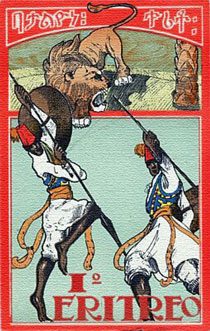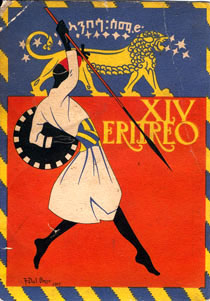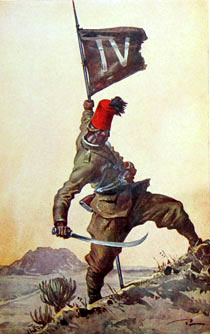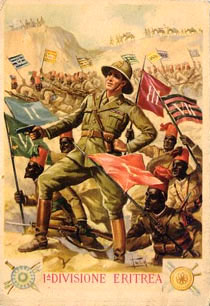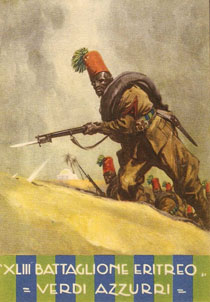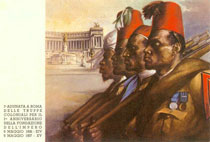WrnzlaAscari: I Leoni d' Eritrea. Coraggio, Fedeltà, Onore. Tributo al Valore degli Ascari Eritrei. |
L'Ascaro del cimitero d'Asmara.
Sessant’anni fa gli avevano dato una divisa kaki, il moschetto ‘91, un tarbush rosso fiammante calcato in testa, tanto poco marziale da sembrare uscito dal magazzino di un trovarobe.
Ha giurato in nome di un’Italia che non esiste più, per un re che è ormai da un pezzo sui libri di storia. Ma non importa: perché la fedeltà è un nodo strano, contorto, indecifrabile. Adesso il vecchio Ghelssechidam è curvato dalla mano del tempo......
Segue >>>
MENU
AREA PERSONALE
TAG CLOUD
ascari ascari eritrei ascari eritrea ascari d'eritrea eritrean ascari eritrea askari eritrean ascari eritrean askari truppe coloniali eritree eritrean colonial troops fanteria eritrea eritrean infantry cavalleria eritrea eritrean cavalry ascari i leoni d'eritrea ascari the lions of eritrea scimbasci muntaz bulucbasci zaptiè
| « Lutto Aprile 2009. Terre... | Immagini. Planimetria de... » |
Controstoria. Etiopia tra miti, leggende.... e finzione.
Post n°250 pubblicato il 15 Aprile 2009 da wrnzla
Controstoria. Etiopia tra miti, leggende e finzione. OROMO. La Storia del colonialismo Abissino ed Italiano scritta dagli Oromo stessi. Tratto da: www.gadaa.com Events in Oromo History During the Reign of Haile Selassie I - 1929 The Oromo fighters of the revolt in Yejju and Rayya controlled a large part of their area and closed the trade route that connected Dasee, the capital of Wallo, to the south. In a battle with the government forces in October 1929, the Oromo fighters captured 2,000 rifles and 12,000 cartridges. - 1930 Tafari Makonnen, throne name Haile Sellassie I, Conquering Lion of the Tribe of Judah, Elect of God and Emperor of Ethiopia, succeeded Zawditu to the throne. - 1930 A large government force, led by the war minister, Mulugeta, arrived in Yejju and Rayya regions. The Oromo fighters put up stiff resistance. The Oromo resistance was finally put down, although temporarily, mainly by the use of airplanes. It was the first time airplanes were ever used in a war in the Empire. - 1931 The first constitution of Ethiopia was introduced. In this document the term "Abyssinia" was dropped in favor of "Ethiopia," thereby defining Abyssinians and all the colonized peoples as "Ethiopians." - 1933 Jimma was fully incorporated into the Ethiopian Empire. - 1933 As the colonial government strengthened its grasp on Oromia and consolidated its power, the situation concerning land and property for Oromo worsened. In 1933 Haile Selassie passed a law decreeing that "... once a person was given to a naftanya he was not allowed to leave the land against the landlord's will ... " - 1935 League of Nations Report C.240, M.171, VII, p.41: "The inhabitants of the conquered country were registered in families by the Abyssinian chiefs, and to every family of Abyssinians settled in the country there is assigned one or more families of the conquered as gabbar. The gabbar family is obliged to support the Abyssinian family, it gives that family its own lands, builds and maintains, the huts in which it lives, cultivates the fields, grazes the cattle, and carries to every kind of work and performs all possible services for the Abyssinian family. All this is done without any remuneration, merely in token of the perpetual servitude resulting from the defeat sustained thirty years ago." - 1935/1936 The Jimma Oromo rose up and attacked colonial officials and settlers, just prior to the Italian invasion. At the time of the Italian invasion, the Jimma population used the situation to their advantage and routed the naftanyas. This doesn't mean they preferred the Italians as masters. In fact, at the time of the Italian invasion of 1936, the Sultan of Jimma, Abbaa Jobir, joined the other Oromo leaders in the region in the independence movement and the establishment of the Western Oromo Confederation. - 1936-1941 The Italian Fascist regime invaded the Ethiopian Empire in revenge for Italy's defeat at the Battle of Adwa some 40 years earlier. A. Sbacchi, "Ethiopia Under Mussolini's Fascism and Colonial Experience," noted "The Oromo ... gained more in the long run than the Amhara from the Italian occupation of Ethiopia, but were not always too cooperative and did not live up to Italian expectations." The Oromo language was used in courts and on radio for the first time. Even some literature appeared in the Oromo language. Haile Sellasie, upon his restoration by the British and against the wishes of the Oromo people, reversed all these positive developments. - 1935/1936 Oromo of Rayya and Qobbo were fighting Haile Selassie's army. At one point, on April 3, 1936 near Ashange Lake, they almost trapped Haile Selassie himself fleeing from the Italians. He never put his feet in this area again after that. During the same period, the Oromo guerrillas attacked the retreating Ethiopian army led by Ras Mulugeta and inflicted heavy casualties. They revenged his earlier (1930) aerial attack on them by killing his son; he himself narrowly escaped. One of the reasons for the attack was, the Ethiopian army on its way to the war had looted the property of the Oromo communities. - 1941 After the Italian defeat and expulsion, many Oromo communities opposed the restoration of Haile Selassie and gabbar (tenancy) system abolished by the Italians. The uprising of Oromo communities in Rayya, Shawa, Hararge, Jimma, etc, were a few centers of opposition. The central and eastern Oromia leaders petitioned the British government for the establishment of an independent Oromia Republic. The request was denied and Haile Selassie was reinstated, which brought to an end for the time being, Oromo's hope for immediate independence. - 1943 The Oromo uprising in Rayya was temporarily suppressed with the assistance of the British Royal Air Force stationed in Aden. Many of the leaders of the Oromo movement were also implicated in the Woyane revolt in Tigray in 1943. - 1945 Oromo communities from Jaarso and Baabbile of eastern Oromia began armed struggle, following the creation of the Somali Youth League in British and Italian Somaliland. Within a short time, they liberated large areas in eastern Hararge, except for large towns like Harrar and Dire Dawa. The Ethiopian government reacted with unexpected violence, and killed many people, razed the countryside, destroyed mosques and other religious centers and property. The fighting subsided temporarily. - 1945 The Jile, pastoral Oromo communities, were evicted from their lands in the upper and middle Hawas (Awash) valley, around Qoqaa (present Qoqaa Dam) and Wanji. Their land was given to Handels Vereniging Amsterdam (HVA), a Dutch firm, with sugar plantations and processing. Those who survived the onslaught of the Ethiopian army among the Jile community of Karrayyu disintegrated and disappeared. The surviving Karrayyu communities moved further south and joined thier kin in the middle Hawas valley. - 1946 At a place called Waleenso near Bookee in Harbo province, Oromo nationalists in the surrounding area organized themselves and fought the colonial regime. The movement was a continuation of that of the previous year and was also in opposition to the restoration of tenancy that had been abolished by the Italians. Among the leaders were Mohammed Jilo and M. Jawwe, who had gained experience in the use of modern arms and fighting during the Italian occupation. The fighters laid down their arms only after they were assured they could continue to administer their area without the interference of the colonial administration. - 1947 The Somali Youth League (SYL) invited Oromo and other groups in Hararge to join them in the struggle against the three colonial powers in the region, British, Italians and Ethiopians, and to build one country together. For fear of unnecessarily aggravating Ethiopian authorities too early, the use of Oromo in the name of the organization was avoided and it was agreed to conduct the struggle under the SYL. But it was perhaps a mistake of historic significance that has plagued the Oromo national struggle up to this moment. - 1948 Oromo leaders in Hararge were able to smuggle in arms through Djibouti. Fighting started simultaneously in British Somaliland and Hararge. This created fear among the settlers. The government was able to suppress the movement after a lot of bloodshed, arrest and imprisonment. Following this event, SYL offices in Harar, Dire Dawa, Dadar, Ginnir, etc were closed down. - 1947/1948 The Rayya Oromo rose up in arms again. Again after they had liberated a large area of their land, the movement was stopped when the British Royal Air Force in Aden at the request of the Ethiopian regime, savagely bombed the Oromo guerrilla positions. - 1950s A peasant revolt broke out in the Dawwe area. The continuous harassment and unwarranted confiscation of Oromo property by the settlers was the immediate cause of the revolt. The Oromo organized themselves into guerrilla forces and forced the colonial settlers and administrators out of the area. Soon the revolt spread and covered a wider area. The guerrilla defeated the government troops, who were sent to quell the revolt, several times and captured arms and ammunition. After several attempts to subdue them with a regular army failed, a detachment of the Imperial Body Guard with combat experience in Korea, led by one of Haile Selassie's generals, in an act of barbarism massacred more than 700 of those who gave themselves up peacefully. Previously, one of the local leaders, Ali Dullatti, slipped out of the war area secretly and traveled to Addis Ababa to appeal to the Emperor, who agreed on amnesty to the fighters. Per articolo completo vedi link: [2] Gli OROMO e L'OROMIA, vedi link: [3] |
INFO
- Due Medaglie d'Oro al Valor Militare alla bandiera al corpo Truppe Indigene d'Eritrea.
- Due Medaglie d'Oro al Valor Militare al gagliardetto dei IV Battaglione Eritreo Toselli.
Medaglia d'oro al Valor Militare alla Memoria.
Medaglia d'oro al Valor Militare alla Memoria.
QUESTA È LA MIA STORIA
.... Racconterà di un tempo.... forse per pochi anni, forse per pochi mesi o pochi giorni, fosse stato anche per pochi istanti in cui noi, italiani ed eritrei, fummo fratelli. .....perchè CORAGGIO, FEDELTA' e ONORE più dei legami di sangue affratellano.....
Segue >>>
CERCA IN QUESTO BLOG
A DETTA DEGLI ASCARI....
...Dunque tu vuoi essere ascari, o figlio, ed io ti dico che tutto, per l'ascari, è lo Zabet, l'ufficiale.
Lo zabet inglese sa il coraggio e la giustizia, non disturba le donne e ti tratta come un cavallo.
Lo zabet turco sa il coraggio, non sa la giustizia, disturba le donne e ti tratta come un somaro.
Lo zabet egiziano non sa il coraggio e neppure la giustizia, disturba le donne e ti tratta come un capretto da macello.
Lo zabet italiano sa il coraggio e la giustizia, qualche volta disturba le donne e ti tratta come un uomo...."
(da Ascari K7 - Paolo Caccia Dominioni)
DISCLAIMER
You are prohibited from posting, transmitting, linking or utilize in any other form the contents relevant to the WRNZLA/BLOG/WEBSITE for offensive purposes including, but is not limited to, sexual comments, jokes or images, racial slurs, gender-specific comments, or any comments, jokes or images that would offend someone on the basis of his or her race, color, religion, sex, age, national origin or ancestry, physical or mental disability, veteran status, as well as any other category protected by local, state, national or international law or regulation.



